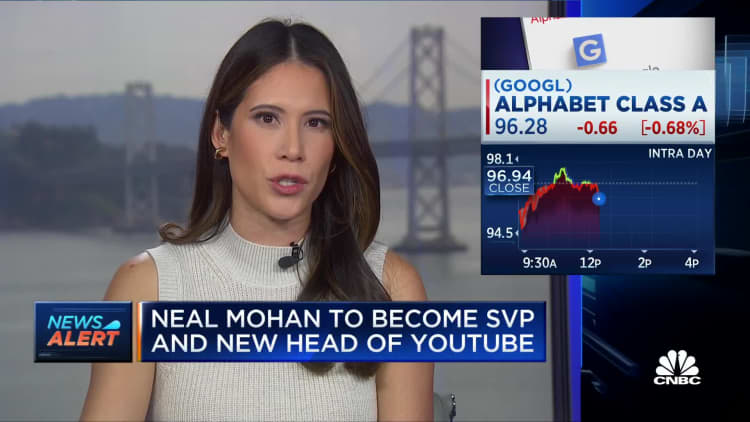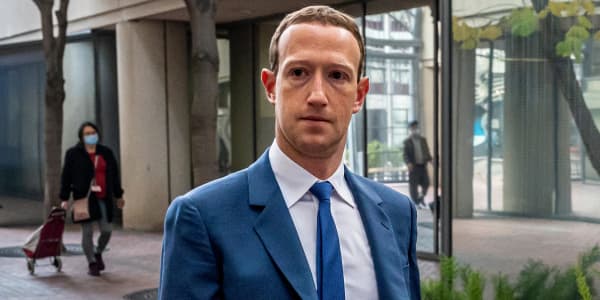YouTube is offering a new monetization model for Shorts to combat TikTok. But creators who have built businesses on the Alphabet-owned social media platform say the biggest money opportunity remains in longer videos.
Matthew Benedetto, the creator of Unnecessary Inventions, a channel with over 10 million followers across all social media platforms, says he still earns more from YouTube, despite having fewer subscribers compared to his 6 million TikTok followers.
"Long-term businesses are built on YouTube," Benedetto said. "With long-form video, you're able to create a deeper connection with the community."
Other creators agree. Several told CNBC still earn higher monthly payouts on YouTube than on other platforms, including TikTok and Reels.
Since the launch of YouTube Shorts' new partnership program on February 1, the results have been mixed. Creators, like Zach King who has over 114 million followers across platforms, took to Twitter to share how the new platform was paying as low as one cent per 1,000 views, while long-form videos can pay up to multiple dollars.
A YouTube spokesperson said it is still early in the effort, and the company is focused on bringing together creators, viewers, and advertisers to grow the Shorts ecosystem.
"As we all invest in Shorts we expect creator earnings to continue to grow. With Shorts ad revenue sharing, we're committed to building a long-term partnership where creators can directly share in the platform's success," the spokesperson said.
The TikTok threat, as well as competition from Meta's Reels product, is growing. That's why YouTube made the change to its payment policy for creators who post to its Shorts platform, now offering creators a share of revenue generated from ads displayed on their content, rather than through a creator fund.
TikTok's success proved to the big social media companies, and the markets, the importance of short-form video, whether that's Snap, YouTube, or Facebook Reels, said Mark Mahaney, Evercore ISI head of internet research. But it's also arrived with unproven economics. "Facebook has been very upfront about the monetization challenges," Mahaney said.
YouTube, which pioneered the idea of sharing ad revenue with creators with the launch of the Partner Program in 2007, will share 45% of the allocated Shorts revenue with creators. If the Short is uploaded with music, that revenue is also split with the music publisher.
The change comes at a crucial time for YouTube, after its revenue fell short of estimates in the most recent quarter, amid a pullback in advertising spending.

Benedetto said that his payments from YouTube Shorts range from $4,000 to $10,000 a month, depending on the total number of views his videos received for that period. Overall, Benedetto's videos have totaled nearly 2 billion views on YouTube, but he says earnings paid out directly from the platform make up just a small percentage of his total.
"AdSense is maybe less than 15% of my revenue," Benedetto said. "For the most part, AdSense is almost bonus revenue for me. For the way I run my business, brand deals are significantly higher."
YouTube has proven to be a powerful platform for creators to build multimillion-dollar businesses. MrBeast, the largest individual creator on YouTube, is seeking to raise $150 million for his business at a valuation of roughly $1.5 billion, according to Axios.
YouTube sees Shorts as a stepping stone for growth on the platform, creating opportunities for small independent creators, but also for the site's highest earners.
"MrBeast is huge on long-form video but Shorts becomes a huge discovery engine," said Rene Ritchie, YouTube's creator liaison. "The revenue from Shorts is probably not huge, but the amount of attention they get that drives back to his main content, make them an incredible awareness vehicle even for somebody even at his current size. Shorts is just so powerful for discovery," Ritchie said.
MrBeast's ongoing multi-million dollar investments in his YouTube videos demonstrate the platform's potential for generating strong returns, attracting influencers with significant followings.
Creators' past criticism of YouTube Shorts payment
Creators had been expressing dissatisfaction with YouTube's approach to paying them for Shorts. Until this month, creators would get a share of the $100 million Shorts Fund, a fixed fund that was divided based on their Shorts viewership.
"One of the issues you face is as more and more creators get involved, the cap on the Shorts Fund stays the same. So, you might be getting many more views. But because other people are as well, you're getting a smaller and smaller cut of the revenue," Ritchie said.
The monthly payment amounts received through creator funds can be subject to fluctuations from month to month, further contributing to dissatisfaction.
"With creator funds, you get a sum of money, but you don't know exactly why you made this amount of money," said Alan Chikin Chow, a creator with over 32 million followers across all platforms. "That clarity of that analytic is so important to me."
TikTok pays its creators through its own TikTok Creator Fund, which the company has pledged to grow from $200 million to $1 billion over the next three years.
Content monetization challenges for TikTok, Reels
TikTok hasn't missed the threat it is facing from YouTube's broader mix of video formats and how creators are "doing the math" on their businesses. It recently launched a new model for longer videos from more established creators.
The Creativity Program Beta is aimed at rewarding creators who post videos longer than one minute and provides enhanced creator tools to those who meet the eligibility criteria. The program, which is a separate fund targeting established creators, promises higher rewards and is part of TikTok's ongoing efforts to attract and retain top content creators.
The invite-only program was created in response to the many creators who said TikTok revenue was often less than the payouts from other platforms since it launched the TikTok Creator Fund in 2020. TikTok says the new program is designed to "encourage creators to create high-quality content, generate higher revenue potential, and open doors to more exciting, real-world opportunities."
On Reels, monetization operates differently. The platform, which is available on Instagram and Facebook, compensates creators with a share based on views received by each Reel. Access to the Reels Play Bonus program is limited to invite-only participants who meet specific qualifications.
"I think Facebook put a lot of effort into trying to replicate the TikTok experience," said V Spehar, host of "Under the Desk News," a short-form news show with nearly 3 million followers on TikTok.
"We're seeing Facebook throw a bunch of money at Reels to try and lure people over. But I worry that once they get you over here, are they going to take care of you? And I don't think the answer is yes," Spehar added.
Although Facebook and Instagram have introduced multiple ways to earn money, creators of short-form content have struggled to sort out the differences in payment methods. Instagram says its monetization strategy for Reels is still being tested out and is continuously changing.
"We're transparent with creators that the requirements and details of each bonus may vary by participant and the amount creators earn per play may not always stay constant," a representative from Instagram said in a statement.
The most successful creators, like MrBeast and Benedetto, aren't relying on any of the platforms directly for their biggest revenue opportunities, with various methods for creators to monetize their content through partnering with brands, licensing deals and selling their products through e-commerce.
With Congress calling for the removal of TikTok from Apple and Google's mobile app stores, creators also are diversifying their presence across platforms as part of risk management.
"I have focused on not putting all my eggs in one basket in TikTok so that if it were to go away that things would still move forward, kind of as it was," Benedetto said.
The technology lends itself to this approach. The standardization of online vertical video makes it easy to create the same content and post it across multiple platforms.
"We want to invest across platforms where we see growth and not a specific platform," said Victor Potrel, vice president of platform partnerships at TheSoul Publishing, which oversees multiple brands that monetize based on short-form content including "5-minute Crafts," the 15th most-subscribed YouTube channel, according to Social Blade.
Allocating advertising for short-form content remains a challenge for these platforms. However, creators agree that short-form content is a great way to get discovered and build an audience.
"We had some viral short-form content with hundreds of millions of views that increased the viewership on the longer-form content as well," Potrel said.
As viewership on platforms increases, Potrel said he hopes to drive that engagement to long-form, which produces better opportunities for monetization on both YouTube and Facebook.
"It's like when online video started 15 to 20 years ago and not everyone knew how it should be monetized. But over time, this has improved and become a huge industry," Potrel said.
Correction: An earlier version of this story misspelled Victor Potrel's name.





